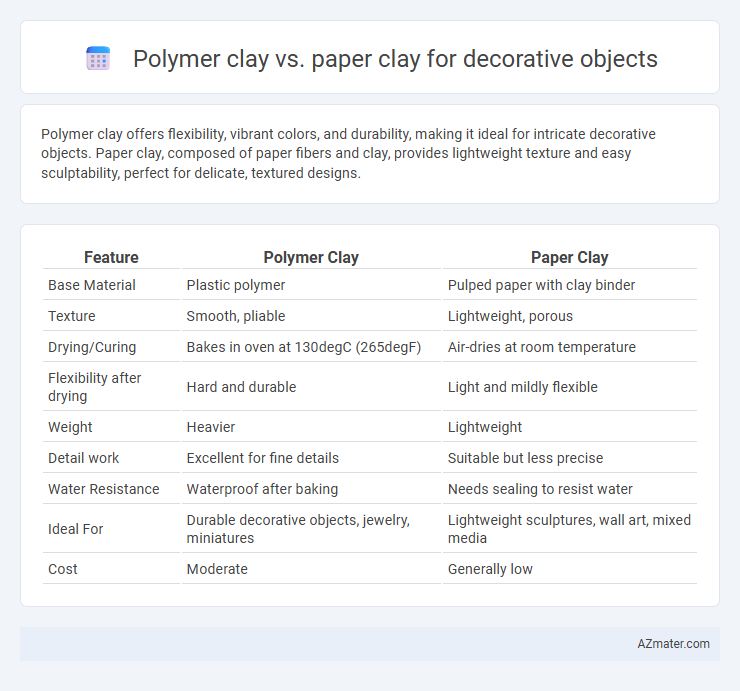Polymer clay offers flexibility, vibrant colors, and durability, making it ideal for intricate decorative objects. Paper clay, composed of paper fibers and clay, provides lightweight texture and easy sculptability, perfect for delicate, textured designs.
Table of Comparison
| Feature | Polymer Clay | Paper Clay |
|---|---|---|
| Base Material | Plastic polymer | Pulped paper with clay binder |
| Texture | Smooth, pliable | Lightweight, porous |
| Drying/Curing | Bakes in oven at 130degC (265degF) | Air-dries at room temperature |
| Flexibility after drying | Hard and durable | Light and mildly flexible |
| Weight | Heavier | Lightweight |
| Detail work | Excellent for fine details | Suitable but less precise |
| Water Resistance | Waterproof after baking | Needs sealing to resist water |
| Ideal For | Durable decorative objects, jewelry, miniatures | Lightweight sculptures, wall art, mixed media |
| Cost | Moderate | Generally low |
Introduction to Polymer Clay and Paper Clay
Polymer clay is a versatile modeling material made from polyvinyl chloride (PVC) that remains soft until baked in an oven, enabling durable and detailed decorative objects with vibrant colors and smooth finishes. Paper clay consists of a mixture of paper fibers and clay that air-dries to a lightweight, porous texture ideal for sculpting delicate or textured decorations with enhanced flexibility before drying. Both materials offer unique properties suited to decorative art, with polymer clay excelling in durability and color variety, while paper clay provides ease of use and a natural matte finish.
Material Composition and Properties
Polymer clay consists mainly of polyvinyl chloride (PVC) combined with plasticizers, providing a flexible, durable, and water-resistant material that hardens when baked. Paper clay incorporates cellulose fibers mixed with traditional clay, offering a lightweight, porous, and air-dryable medium with enhanced crack resistance and easy sanding properties. The denser, non-porous nature of polymer clay suits detailed, vibrant decorative objects, while paper clay's lightness and texture favor sculptural works requiring surface refinement.
Ease of Use and Workability
Polymer clay offers excellent ease of use due to its pliability, no need for water, and ability to hold fine details, making it ideal for intricate decorative objects. Paper clay, containing cellulose fibers, provides superior workability by allowing additions and blending while wet, along with a lightweight texture that dries hard but remains slightly porous for sanding and painting. Both clays are versatile, but polymer clay cures permanently in an oven, whereas paper clay air-dries, influencing work time and finishing techniques.
Curing and Drying Methods
Polymer clay cures through oven baking at temperatures between 230degF and 275degF, allowing it to harden quickly and achieve a durable, water-resistant finish. Paper clay air dries by releasing moisture, typically requiring 24 to 72 hours to fully dry, resulting in a lightweight, porous, and matte surface. The curing method of polymer clay offers faster, heat-induced hardening, while paper clay relies on natural evaporation, influencing project timelines and final texture.
Strength and Durability Comparison
Polymer clay exhibits superior strength and durability compared to paper clay, making it ideal for long-lasting decorative objects exposed to handling and environmental stress. Its synthetic composition allows it to harden more uniformly upon baking, resulting in a rigid, water-resistant finish that resists cracking and chipping. Paper clay, while lighter and easier to sculpt, tends to be more porous and fragile, often requiring sealing to enhance durability but remaining less resilient under physical stress.
Surface Finish and Detailing
Polymer clay offers a smooth, glossy surface finish that enhances intricate detailing and provides vibrant color retention for decorative objects. Paper clay, composed of paper fibers, creates a matte, textured surface ideal for rustic or organic looks but may limit fine detailing precision. The choice depends on the desired finish--polymer clay for sharp details and sleek surfaces, paper clay for a natural, textured appearance.
Weight and Texture Differences
Polymer clay is denser and heavier than paper clay, providing a solid, smooth finish ideal for detailed, durable decorative objects. Paper clay is lighter due to its cellulose fiber content, resulting in a softer texture that is easier to carve and sand, making it suitable for fragile or intricate designs. The weight difference affects the choice of materials for display or wearable decorations where comfort and handling are important.
Safety and Environmental Considerations
Polymer clay, made from polyvinyl chloride (PVC), releases potentially harmful fumes when baked at high temperatures, posing health risks without proper ventilation, while paper clay is composed of natural fibers and clay, making it non-toxic and safer for indoor use. Environmentally, paper clay is biodegradable and more eco-friendly, breaking down naturally without leaving harmful residues, whereas polymer clay is non-biodegradable and contributes to plastic waste. Choosing paper clay supports sustainable crafting practices and reduces exposure to toxic substances compared to synthetic polymer clay.
Cost and Availability
Polymer clay typically costs more per pound than paper clay but is widely available in art supply stores and online, making it accessible for most hobbyists. Paper clay, often less expensive and lightweight, may be harder to find in standard retail stores but is readily available through specialized suppliers. Considering budget and ease of purchase, polymer clay offers consistent availability, while paper clay provides a cost-effective alternative for decorative object crafting.
Best Applications for Decorative Objects
Polymer clay excels in creating detailed and durable decorative objects due to its versatility, vibrant color options, and ability to be baked for long-lasting finishes. Paper clay offers a lightweight, matte texture ideal for delicate, sculptural pieces that require sanding and painting post-drying, making it perfect for intricate or larger-scale decorations. Both materials suit different decorative needs, with polymer clay best for colorful, polished designs and paper clay preferred for textured, natural-looking art.

Infographic: Polymer clay vs Paper clay for Decorative object
 azmater.com
azmater.com